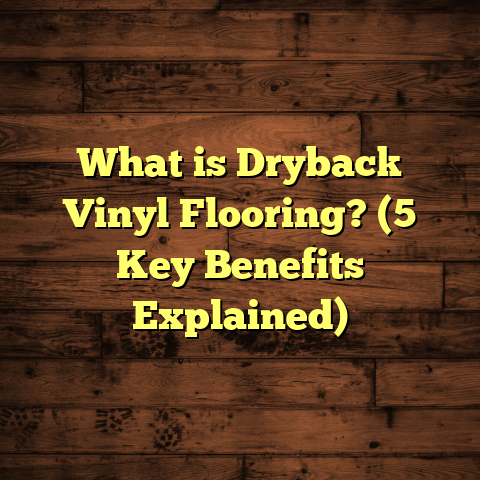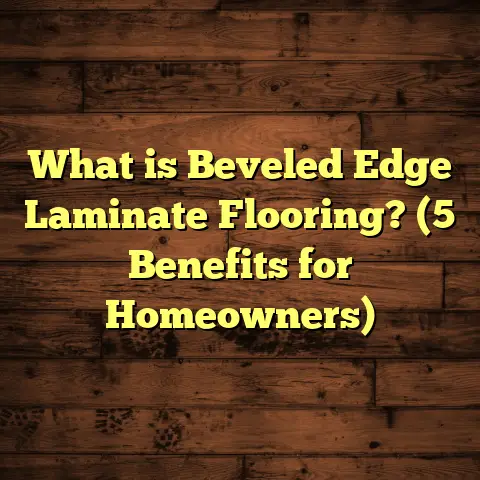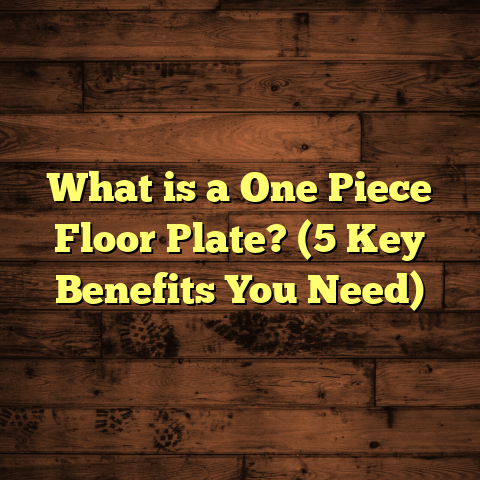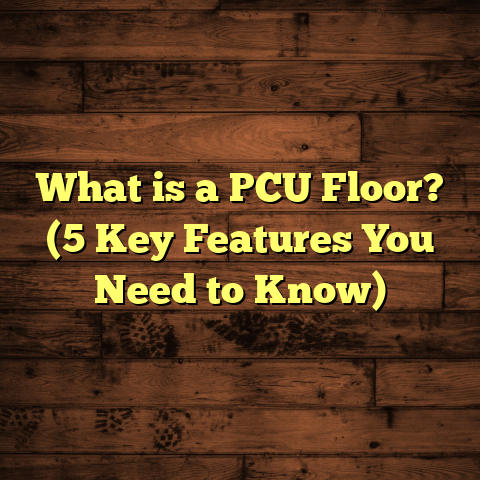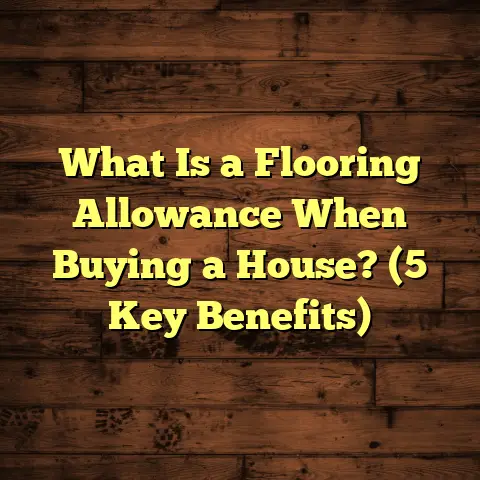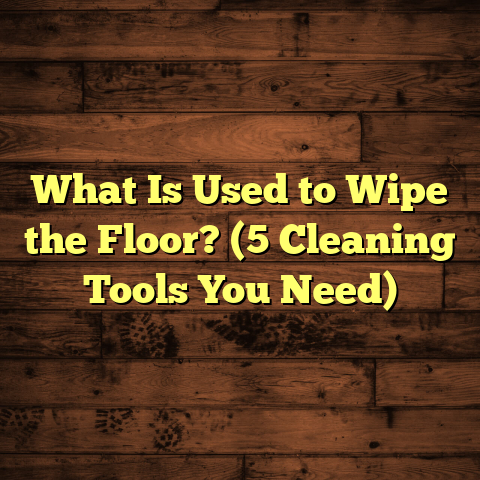What is EVP in Flooring? (5 Key Benefits for Durability)
When someone walks into your home, what catches their eye first? For me, it’s often the floors. No matter how stylish the furniture or how vibrant the walls, the floor sets the foundation—literally and figuratively. I’ve spent years helping homeowners pick out and install flooring that not only looks amazing but also stands up to daily life. If you’ve been browsing options lately, you might have heard about EVP flooring. Maybe you’re curious: What exactly is EVP? Why is it so popular? And how durable is it really?
Let’s chat about EVP and why it’s become a go-to choice for so many people, including myself and my clients.
What is EVP in Flooring?
EVP stands for Engineered Vinyl Plank. It’s a type of vinyl flooring designed to look like real hardwood or stone but built to tackle some of the biggest problems that come with natural materials—like water damage, scratches, or swelling.
When I first came across EVP a few years back, I was working on a basement renovation for a family in Minneapolis. Their basement had moisture issues that made hardwood flooring a no-go option. We wanted something that resembled wood but wouldn’t warp or get ruined by humidity or accidental spills. EVP fit the bill perfectly.
Unlike traditional vinyl flooring, which can be flexible and sometimes feel thin or flimsy underfoot, EVP has a rigid core. This means it’s solid and strong, providing stability similar to engineered hardwood but with superior water resistance.
The Construction of EVP
To understand why EVP is so durable, it helps to look at what it’s made of:
- Top Layer (Wear Layer): This transparent layer protects from scratches, stains, and dents. It’s like the skin of the floor.
- Decorative Layer: A high-resolution printed vinyl film that gives EVP its realistic appearance—whether it’s mimicking oak grain, stone texture, or even ceramic tile patterns.
- Rigid Core: The main structural component. It’s usually made from limestone composite or wood plastic composite materials. This core gives EVP its strength and stability.
- Backing Layer: This adds balance to the plank and sometimes helps with sound absorption or moisture protection.
This layered design is what makes EVP stand out compared to other vinyl products and laminate floors.
How EVP Differs From Other Floors
People often confuse EVP with laminate or standard vinyl plank flooring. Here’s what I’ve learned helps explain the differences:
- Laminate Flooring: Made of fiberboard core topped with a photographic layer and protective coating. It looks like wood but isn’t waterproof and can swell if exposed to moisture.
- Traditional Vinyl: Usually softer, thinner vinyl sheets or planks with no rigid core. Waterproof but can feel hollow or cheap.
- Engineered Hardwood: Thin layers of real wood over plywood core. Looks great but vulnerable to water damage.
- EVP: Combines rigid core with waterproof vinyl top layers, offering both durability and realistic aesthetics.
The 5 Key Benefits of EVP for Durability
Over several years installing floors in all kinds of environments—homes with kids and pets, commercial spaces with high foot traffic, even vacation homes near water—I’ve seen first-hand how EVP performs. Durability is always something clients ask about because they want a floor that lasts without constant repairs or replacement.
Here are five reasons why EVP ranks highly in my book for durability:
1. Waterproof Nature That Really Works
Water damage is one of the most common enemies of flooring. Hardwood swells and warps when exposed to moisture, laminate peels up at seams, and carpet just soaks it in.
EVP is different because its core is completely waterproof. This means it can survive spills, pet accidents, even flooding without permanent damage.
I remember a client whose dishwasher leaked continuously under their kitchen floor before they noticed. By the time they caught it, their EVP floor had been exposed for hours but showed no signs of buckling or warping.
Some brands of EVP can handle standing water for up to 72 hours without damage. That kind of tolerance isn’t something you find with hardwood or laminate.
Data Point: According to a study by the Vinyl Flooring Institute, EVP products tested maintained structural integrity after 48 hours of water exposure in lab conditions, outperforming engineered hardwoods by 80% in moisture resistance.
2. Resistance to Scratches, Scuffs, and Dents
If your home has kids running around or pets with sharp claws (like mine!), you know how quickly floors can get scratched.
The wear layer on quality EVP planks is designed to protect against everyday scratches from shoes, toys, or furniture movement.
One commercial project I worked on was an office lobby where rolling chairs and heavy traffic happen all day. After nearly a year, the EVP floor still looked fantastic with only minor superficial marks that didn’t penetrate past the wear layer.
The thickness of this wear layer varies—generally between 12 mil (0.3 mm) and 30 mil (0.76 mm). The thicker it is, the better protection you get.
Quick Tip: For homes with pets or kids, I usually recommend looking for EVP flooring with at least an 18 mil wear layer to balance durability with cost.
3. Dimensional Stability — No Warping or Gapping
Floors expand and contract with changes in temperature and humidity. Solid wood floors can sometimes buckle or create gaps if acclimation isn’t done right before installation.
EVP’s rigid core keeps things stable through seasonal changes. I’ve installed EVP in basements where temperature swings are pronounced and never had complaints about planks lifting or gaps opening up.
This stability also means less noise—no creaking boards as you walk across—and fewer worries about uneven surfaces developing over time.
Personal Anecdote: Once I helped a homeowner install EVP in their sunroom where sunlight and temperature vary widely daily. The floor still looked perfect two years later without any gaps or warping caused by heat exposure.
4. Easy Maintenance Saves Time and Money
Durability doesn’t just mean withstanding damage; it also involves how much effort you spend keeping the floor looking good over time.
EVP floors are simple to clean—usually just regular sweeping or vacuuming plus occasional mopping with water or mild cleaners.
No need for waxing, polishing, or special treatments like hardwood requires. This makes it ideal for busy families or commercial spaces where maintenance budgets are tight.
I’ve seen clients save hundreds of dollars annually on cleaning supplies and labor compared to hardwood or carpet because EVP requires less care.
Fun Fact: Some brands even offer antimicrobial wear layers that resist bacteria growth, perfect for households concerned about hygiene.
5. Longevity That Matches Its Appearance
You want your investment to last—not just functionally but also visually. EVP offers 15-20 years of lifespan on average when installed properly and cared for as recommended.
I’ve inspected floors I installed almost a decade ago still looking great without signs of delamination or fading.
Some manufacturers provide warranties up to 25 years for residential use, which gives peace of mind when choosing this flooring type.
Case Study: A retail store I worked with installed EVP flooring eight years ago in their high-traffic aisles. They reported minimal wear despite thousands of customers walking daily—proof that durable materials paired with good installation make all the difference.
Why Durability Matters More Than Ever
You might be wondering: Why focus so much on durability? Isn’t style more important?
I’d argue that style matters only if your floors last long enough to enjoy it! A beautiful floor that gets ruined by scratches or moisture within a couple of years ends up costing more money and frustration than picking a slightly less trendy but durable option upfront.
From my experience, durable floors reduce stress about accidents—kids spilling drinks or pets scratching—and save money on repairs or replacement in the long run.
Plus, durability often correlates with better installation processes and material quality overall, so you usually get improved aesthetics as well.
How Price Factors Into Choosing EVP
Of course, price is always on everyone’s mind when choosing flooring. You want durability but you also want affordable options.
EVP generally falls into a mid-range price category: more expensive than basic vinyl sheets or laminate but less costly than solid hardwood or premium engineered wood.
Depending on brand, product quality, wear layer thickness, and style complexity, prices typically range from $3 to $7 per square foot for materials alone.
Labor usually runs $1 to $3 per square foot depending on location and project complexity.
Managing Costs With Tools Like FloorTally
When I plan flooring projects now, I rely heavily on cost estimating tools like FloorTally to help figure out precise budgets early on.
With FloorTally, I enter project dimensions, material preferences (like EVP type), local labor rates, and waste factors into one platform.
This eliminates guesswork about how much material to order (including cutting waste) and how much installation will cost based on current market prices where I am working.
For example: For a 1,000 square foot living room/kitchen combo using mid-grade EVP with a 20 mil wear layer, FloorTally calculates total costs including labor at around $5,000-$6,500 depending on waste allowance and additional trim pieces needed.
This kind of precision helps me advise clients realistically so there are no surprises later—and keeps projects running smoothly from start to finish.
Installation Tips I’ve Learned Over Time
The best materials won’t perform well without proper installation. With EVP floors becoming more popular, I’ve picked up some valuable tips along the way:
- Acclimate Planks Before Installation: Even though EVP is stable, allowing planks to sit in the room for 48 hours before installation helps avoid minor expansion issues.
- Use Proper Underlayment: Some brands recommend soundproofing underlayments which also provide moisture barriers—especially important on concrete slabs.
- Leave Expansion Gaps: Like all floating floors, EVP needs space around edges to expand slightly without buckling.
- Avoid Glue Unless Specified: Many EVPs use click-lock systems that don’t require glue—this speeds up installation and makes future repairs easier.
- Clean Subfloor Thoroughly: A smooth dry surface ensures planks lay flat without bumps or uneven joints forming later.
Following these steps has saved me headaches on multiple projects where rushed installers skipped key details—and ended up needing costly fixes down the road.
Comparing EVP Durability With Other Popular Flooring Types
Sometimes clients ask me how EVP stacks up against other options like hardwood, laminate, tile, or carpet when durability is the main concern. Here’s a quick overview based on my experience combined with industry data:
| Flooring Type | Water Resistance | Scratch Resistance | Stability (Temp/Humidity) | Maintenance Ease | Expected Lifespan |
|---|---|---|---|---|---|
| EVP | Excellent | High | Very Stable | Easy | 15-20 years |
| Hardwood (Solid) | Poor | Moderate | Expands/Contracts | Moderate (needs care) | 20-30 years |
| Laminate | Low | Moderate | Expands/Contracts | Easy | 10-15 years |
| Traditional Vinyl | Excellent | Moderate | Stable | Very Easy | 10-15 years |
| Tile | Excellent | Very High | Very Stable | Moderate (grout care) | 20+ years |
| Carpet | Poor | Low | Stable | High (cleaning) | 5-10 years |
From this table alone, you can see why many people prefer EVP when they want something long-lasting but easier to maintain than hardwood or more comfortable than tile.
My Personal Take on Why EVP Works
In all honesty, I think EVP hits a sweet spot that’s hard to beat right now: it looks good enough to rival real wood floors but handles everyday life better than many alternatives.
It’s not perfect for every situation—if you want authentic hardwood feel or plan to refinish your floor multiple times over decades then hardwood might still be worth considering.
But for most homeowners looking for practical beauty combined with resilience? EVP really delivers.
I’ll never forget one client who told me after installing EVP: “I don’t worry about spills anymore. I don’t have to baby-proof my floors.” That peace of mind alone makes it worth it for many families I work with.
Addressing Common Questions About EVP Durability
Since talking about durability raises plenty of questions from clients and readers alike, here are some quick answers based on my experience:
Q: Can EVP be installed in basements?
A: Absolutely! Its waterproof core makes it ideal for below-grade installations where moisture risks are higher.
Q: How does EVP handle heavy furniture?
A: The rigid core prevents denting under heavy furniture better than laminate or traditional vinyl. Use furniture pads to protect surfaces further.
Q: Will pets scratch EVP?
A: Quality wear layers resist pet claws well; however, very aggressive scratching can leave marks over time as with any floor type.
Q: Can I install EVP over radiant heating?
A: Yes! Many EVPs are compatible with radiant heat systems but always check manufacturer specs before installation.
Q: How long will the floor last?
A: With proper care and installation, expect 15-20 years at minimum; some brands offer warranties up to 25 years residential use.
Final Thoughts: Is EVP Right For You?
If you’re weighing your options and durability ranks high on your list alongside style and ease of care, EVP deserves serious thought.
It combines:
- Waterproof core that avoids warping
- Scratch-resistant wear layers
- Stability against temperature swings
- Simple maintenance routines
- Proven longevity backed by warranties
With modern printing technology making planks look incredibly real—and flexible installation methods saving time—it’s no wonder more people turn to EVP today than ever before.
Thinking about trying it out? Reach out to local installers who can show samples in your space under different lighting conditions—that helps pick colors and textures that truly fit your style.
And if you want help figuring out budgets or quantities needed for your project like I do every day, tools like FloorTally will save you time and avoid costly mistakes in ordering material or labor planning.
I hope this gives you a thorough understanding of what EVP flooring is all about and why durability plays such a big role when choosing floors that last through life’s ups and downs.
Have you experienced any flooring challenges yourself? Or maybe you’re planning a project soon? Let me know—I’m always happy to share insights from my experience working hands-on with different floors across many homes and businesses!
